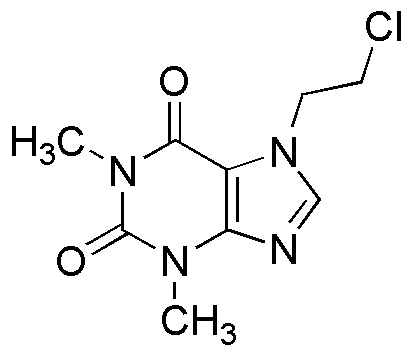7-(2-Chloroethyl)theophylline is widely utilized in research focused on:
- Pharmaceutical Development: This compound is explored for its potential as an anti-cancer agent, particularly in targeting specific types of tumors, offering a novel approach compared to traditional chemotherapy.
- Drug Delivery Systems: Its unique chemical structure allows for the development of targeted drug delivery systems, improving the efficacy and reducing side effects of medications in patients.
- Respiratory Therapies: Leveraging its theophylline base, it is being investigated for enhanced treatments for respiratory conditions, such as asthma and COPD, providing better bronchodilation effects.
- Research in Biochemistry: This compound serves as a valuable tool in biochemical research, helping scientists understand the mechanisms of action of various cellular processes and drug interactions.
- Veterinary Medicine: It is also studied for its applications in veterinary medicine, particularly in treating respiratory issues in animals, showcasing its versatility across species.
General Information
Properties
Safety and Regulations
Applications
7-(2-Chloroethyl)theophylline is widely utilized in research focused on:
- Pharmaceutical Development: This compound is explored for its potential as an anti-cancer agent, particularly in targeting specific types of tumors, offering a novel approach compared to traditional chemotherapy.
- Drug Delivery Systems: Its unique chemical structure allows for the development of targeted drug delivery systems, improving the efficacy and reducing side effects of medications in patients.
- Respiratory Therapies: Leveraging its theophylline base, it is being investigated for enhanced treatments for respiratory conditions, such as asthma and COPD, providing better bronchodilation effects.
- Research in Biochemistry: This compound serves as a valuable tool in biochemical research, helping scientists understand the mechanisms of action of various cellular processes and drug interactions.
- Veterinary Medicine: It is also studied for its applications in veterinary medicine, particularly in treating respiratory issues in animals, showcasing its versatility across species.
Documents
Safety Data Sheets (SDS)
The SDS provides comprehensive safety information on handling, storage, and disposal of the product.
Product Specification (PS)
The PS provides a comprehensive breakdown of the product’s properties, including chemical composition, physical state, purity, and storage requirements. It also details acceptable quality ranges and the product's intended applications.
Certificates of Analysis (COA)
Search for Certificates of Analysis (COA) by entering the products Lot Number. Lot and Batch Numbers can be found on a product’s label following the words ‘Lot’ or ‘Batch’.
Numéro de catalogue
Numéro de lot/série
Certificates Of Origin (COO)
This COO confirms the country where the product was manufactured, and also details the materials and components used in it and whether it is derived from natural, synthetic, or other specific sources. This certificate may be required for customs, trade, and regulatory compliance.
Numéro de catalogue
Numéro de lot/série
Safety Data Sheets (SDS)
The SDS provides comprehensive safety information on handling, storage, and disposal of the product.
DownloadProduct Specification (PS)
The PS provides a comprehensive breakdown of the product’s properties, including chemical composition, physical state, purity, and storage requirements. It also details acceptable quality ranges and the product's intended applications.
DownloadCertificates of Analysis (COA)
Search for Certificates of Analysis (COA) by entering the products Lot Number. Lot and Batch Numbers can be found on a product’s label following the words ‘Lot’ or ‘Batch’.
Numéro de catalogue
Numéro de lot/série
Certificates Of Origin (COO)
This COO confirms the country where the product was manufactured, and also details the materials and components used in it and whether it is derived from natural, synthetic, or other specific sources. This certificate may be required for customs, trade, and regulatory compliance.


